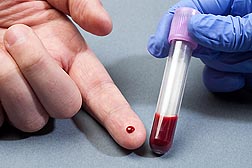This page has been archived and is being provided for reference purposes only. The page is no longer being updated, and therefore, links on the page may be invalid.
| Read the magazine story to find out more. |
|
| Listen to podcast. |
|
Improved Vitamin B12 Test May Help Young and Old Alike
By Marcia WoodApril 22, 2013
In the United States, the very young and the elderly are among the groups at risk of becoming deficient in vitamin B12, an essential nutrient. Now, a team of U.S. Department of Agriculture (USDA) scientists led by research chemist John W. Newman has developed and tested an improved method for measuring an indicator of the body's stores of B12 in blood.
Importantly, the blood sample can be very small in volume. That's an advantage in both medical and research situations. Blood samples that are taken from newborns and infants—for health exams at a hospital, or perhaps for use by medical or nutrition researchers—are typically very small. In addition, a small amount of sample is often the norm in complex, large-scale studies in which blood samples from volunteers have to be allocated among many researchers, each of whom may need it for a different research purpose.
Newman and his colleagues have shown that a specimen of only 25 microliters of blood plasma or serum—the equivalent of about one-half of a drop of water—can be analyzed with speed, accuracy, reliability and precision using an analytical technology called UPLC-ESI-MS/MS (ultra-performance liquid chromatography-electrospray ionization-tandem mass spectrometry).
If the assay is performed using robotics, the sample could perhaps be as small as 5 microliters, according to Newman.
His team built upon earlier work in which scientists elsewhere used an older technology to measure the same indicator compound that Newman's group selected, namely, MMA (methylmalonic acid). MMA can build up in the bloodstream if there isn't enough vitamin B12 in the body.
The 25-microliter sample size needed for the new MMA assay represents a 4- to 10-fold reduction in the volume of specimen required for other MMA-based B12 tests. Samples take only about four minutes to process, according to Newman, who works at the Agricultural Research Service (ARS) Western Human Nutrition Research Center in Davis, Calif. ARS is the chief intramural scientific research agency of USDA, and the B12 research supports the USDA priority of improving children's health and nutrition.
In developing the assay, Newman collaborated with Lindsay H. Allen, director of the ARS research center, and with three other ARS colleagues: chemist Theresa L. Pedersen, physical scientist William R. Keyes, and nutritionist Setareh Shahab-Ferdows. The team documented the research in a peer-reviewed article published in 2011 in the Journal of Chromatography B.
Read more about this research in the April 2013 issue of Agricultural Research magazine.

